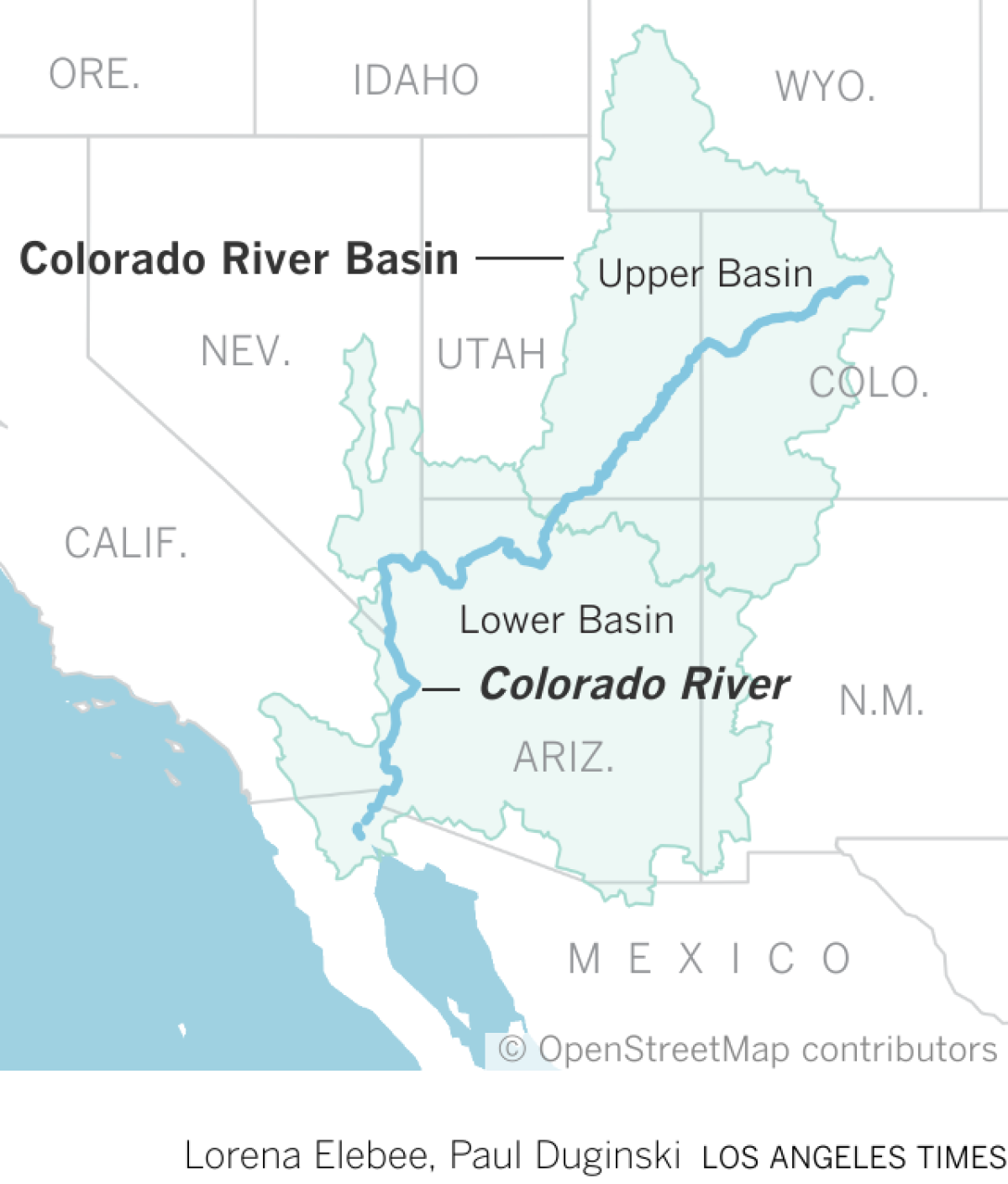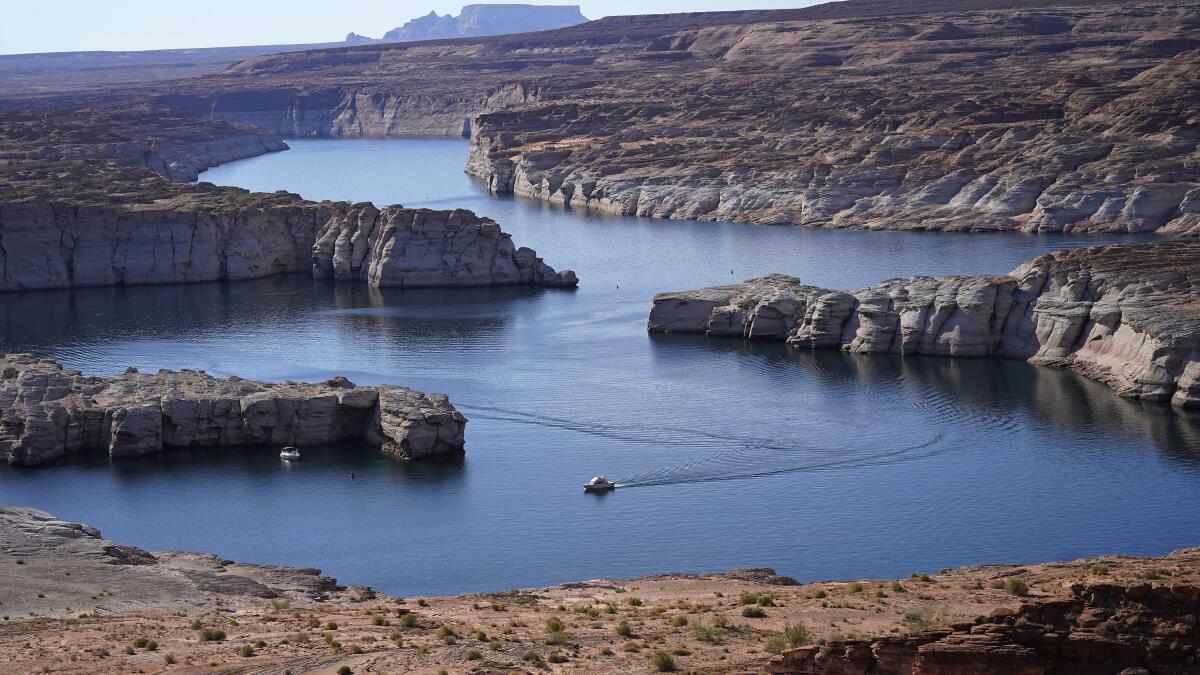Where California stands in the multistate negotiations over the Colorado River

- Share via
Good morning. Here’s what you need to know to start your day.
- Seven states battle for their share of the Colorado River.
- A ferocious wildfire spread rapidly early Tuesday in Malibu, spurring mass evacuations and a “shelter-in-place” order at Pepperdine University.
- Here’s everything new coming to Disneyland in 2025 (so far) — including $67-per-day tickets.
- And here’s today’s e-newspaper.
Sign up for Essential California
The most important California stories and recommendations in your inbox every morning.
You may occasionally receive promotional content from the Los Angeles Times.
Progress is not flowing in Colorado River negotiations
What happens at the Colorado River conference in Las Vegas stays at the Colorado River conference in Las Vegas — because nothing really happened.
A multistate effort to lock in long-term plans for conserving vital shared water from the struggling Colorado River remains stalled.
The conference is typically an opportunity for the seven states that rely on the river — California, Nevada, Arizona, New Mexico, Colorado, Utah and Wyoming — to come to the table and make progress on a deal. But not this year.
“Those on both sides say they are willing to continue trying to reach a deal on how to apportion cutbacks in water use after 2026, when the current rules expire,” Times reporter Ian James wrote this week. “But they also say easing the stalemate will be difficult.”

Basin-based tensions
The rift has widened between the three states in the river’s lower basin (California, Nevada and Arizona) and the four upper basin states (Wyoming, Utah, Colorado and New Mexico).
Dueling proposals from both camps outline how mandatory cutbacks should be determined and how much water each state would be mandated to cut back. Each group views the other’s proposal as unfairly burdening them.
Ian also noted that water managers in the upper basin states are facing criticism “for moving ahead with plans for new dams and diversions that would take more water from the river.”
As the impasse continues, so has public finger-pointing. Previous conferences included closed-door meetings of representatives from all seven states, but no meeting was scheduled this year. Some reps accused the other side of undermining efforts to hash out an agreement.
Still, some expressed optimism that they can get a deal done.
“I really feel like we might want to spend some time looking at where we have some common ground, and see what we can build on from there,” Becky Mitchell, Colorado’s top negotiator, told Ian. “We have to look at what the supply is and share that.”

A river in peril
The Colorado River originates in the Rocky Mountains and is a key source of the water we and our crops drink. Among the seven states that rely on the waterway, California takes the biggest gulp. In 2020, 4.1 million acre-feet streamed into the Golden State (more than 1 trillion gallons) out of more than 11 million acre-feet sent out across the West (Mexico also receives water from the river).
The seven-state arrangement to share the river’s water was established with the Colorado River Compact, signed in 1922. Even before that, some scientists warned that the river could not sustain that level of demand.
A century later, those concerns are on full display in near-empty reservoirs, receding lakes and dusty stretches of desert where the river once flowed.
“The average flow of the river has shrunk about 20% since 2000,” Ian wrote.
“California water agencies say they have reduced water use by more than 1.2 million acre-feet over the last two years, decreasing the state’s usage of Colorado River supplies to the lowest levels since the 1940s,” he added.

Looking downstream
If the seven states can’t reach an agreement, a legal battle could ensue, Ian noted, though that would bring “uncertainty that water managers in both camps have said they hope to avoid.”
Experts at the conference floated the possibility that the aquatic quarrel could make its way to the Supreme Court, though that’s viewed as a crisis that should be averted.
I wondered what impact the incoming Trump administration could have in negotiations, so I asked Ian about that. He believes the president and his team will follow their predecessor’s administration in being largely hands-off. Why? To avoid “making enemies in states where they’d like political support,” he said.
“Eventually, Trump will appoint people to lead the Bureau of Reclamation, who will set the tone with their decisions about the federal environmental review,” Ian told me. “Those appointees will likely play a key role as encouragers — encouraging the states to get a deal done.”
Today’s top stories

Firefighters struggled to battle a wildfire that was spreading rapidly early Tuesday in Malibu, spurring mass evacuations
- Dubbed the Franklin fire, the blaze was moving at a fierce pace, fanned by strong Santa Ana winds. Some 6,000 residents live in the area ordered evacuated, firefighters said.
- You can find information about evacuations, road closures, shelters in Malibu and more in this link.
- The Franklin fire is being fueled by a combination of dangerous winds, dry conditions and low humidity. How long will these dangerous conditions last?
- A Malibu councilman watched from a distance as the fire surrounded his home. “I think I’m in shock,” he said.
The suspect in the killing of UnitedHealthcare’s CEO had ties to Santa Monica and Stanford, records show
- The suspect — 26-year-old Luigi Mangione — spent time at Stanford University in 2019 and once worked for Santa Monica-based TrueCar, a digital marketplace for automobiles, public records show.
- A Stanford University spokesperson confirmed that a person named Luigi Mangione was employed as a head counselor under the Stanford Pre-Collegiate Studies program between May and September of 2019.
Schiff opposes a preemptive pardon from Biden as Trump again threatens sending him to jail
- Sen. Adam B. Schiff on Monday said he doesn’t want President Biden to establish a partisan precedent. “It would be another diminution in our democracy and I just think it’s completely unnecessary,” he told The Times.
- Schiff’s comments come after Trump on Sunday said members of Congress who investigated the Jan. 6, 2021, Capitol insurrection should be imprisoned.
Where Trump gained ground in Southern California
- A red tide washed through the once strongly liberal Pico-Robertson neighborhood in recent months. Locals attribute the shifting dynamics to the Israel-Hamas war, rising instances of antisemitism and a strong Republican canvassing effort.
- In Arcadia and Temple City, Asian American voters supported Trump, expressing despair over crime, the economy and illegal immigration.
- And in Downey, a suburb dubbed the Mexican Beverly Hills, Trump narrowed the gap between his Democratic rivals.
What else is going on
- OpenAI’s controversial Sora finally launched. Will it truly disrupt Hollywood?
- A 41-year-old cold case murder in Newport Beach was cracked by new interviews, police said.
- Here’s how you can get California to help pay for your e-bike this Christmas.
- “Polarization” is Merriam-Webster’s 2024 word of the year.
Get unlimited access to the Los Angeles Times. Subscribe here.
Commentary and opinions
- Trump promised he won’t cut Social Security. Columnist Anita Chabria asks, Should you trust him?
- It’s past time for city officials to let Venice Dell homeless housing move ahead, the Editorial Board writes.
- Proposition 187 and battles over illegal immigration are rapidly ceasing to define a Latino electorate that is increasingly U.S.-born and concerned about the economy, writes Mike Madrid, a political consultant and the author.
- This condiment is the only sauce you’ll need to hack the holidays, columnist Jenn Harris writes.
This morning’s must read
A day without Mexicans in Mammoth? Like many California resort towns, Mammoth Lakes is reliant on undocumented workers. Locals say the economy will grind to a halt if the town gets swept up in President-elect Donald Trump’s vows of mass deportations.
Other must reads
- The “Shohei economy” has transformed the Dodgers financially in just one year.
How can we make this newsletter more useful? Send comments to [email protected].
For your downtime

Going out
- 🎡 Here’s everything new coming to Disneyland in 2025 (so far) — including $67-per-day tickets.
- 🌱 Feeling stressed? We tested the best grassy hills to roll down in Los Angeles County.
- 🎤 Taylor Swift finished her Eras tour with the assurance of a pro, our music critic writes.
Staying in
- 📚 Here are the 15 best books of 2024, according to three critics.
- 🍿 “Emilia Pérez” and “The Brutalist” led the motion picture nominees for the 82nd Golden Globe Awards, while “The Bear” topped the TV field.
- 📺 HBO’s “Somebody Somewhere,” which ended Sunday after three seasons, was epic television, our critic writes.
- 🧑🍳 Here’s a recipe for chocolate and pink peppercorn meringues.
- ✏️ Get our free daily crossword puzzle, sudoku, word search and arcade games.
A question for you: What are your favorite holiday traditions?
Lisa writes: “Every year I make at least one batch of persimmon cookies from my Aunt Genevra’s recipe. Hachiya (tall) persimmons from a friend’s tree or local California farmer’s market with holiday spices bring back wonderful memories!”
Email us at [email protected], and your response might be included in the newsletter this week.
And finally ... your great photo of the day

Today’s great photo is from Danny Becerra of Monrovia: the natural beauty of Borrego Springs.
Danny writes: “Borrego Springs is a popular desert hiking destination all year round, but after a heavy rainy season it becomes a cavalcade of color from the super bloom that follows. The night sky is just as special. The desert is also one of the best places in the state for stargazing.”
Show us your favorite place in California! Send us photos you have taken of spots in California that are special — natural or human-made — and tell us why they’re important to you.
Have a great day, from the Essential California team
Ryan Fonseca, reporter
Defne Karabatur, fellow
Andrew Campa, Sunday reporter
Hunter Clauss, multiplatform editor
Christian Orozco, assistant editor
Stephanie Chavez, deputy metro editor
Karim Doumar, head of newsletters
Check our top stories, topics and the latest articles on latimes.com.
Sign up for Essential California
The most important California stories and recommendations in your inbox every morning.
You may occasionally receive promotional content from the Los Angeles Times.




